Marine Threat: Coral Bleaching
Marine Threat: Coral Bleaching
Consultant: Edward Perello
Academic & Industry Experts: John Carlin (Fincasters), Philip Cleves (Stanford University), Jamie Craggs (Horniman Museum), Craig Downs (Haereticus Institute), James Deutsch (Vulcan), Ruth Gates (Hawaii Institute of Marine Biology), Gator Halpern (Cora Vita), Mary Hagedorn (Smithsonian Conservation Biology Institute), Petra Lundgren (Great Barrier Reef Foundation), Kristen Marhaver (Caribbean Research and Management of Biodiversity), Chris Meckley (ACI Aquaculture), Caroline Palmer (University of Plymouth), Stephen Palumbi (Stanford University), Stephen Ranson (Coral Vita), Forest Rohwer (San Diego University), Sam Teicher (Coral Vita), and Madeleine van Oppen (Australian Institute for Marine Science)
Pictured Above: Bleached coral on the Great Barrier Reef. As average sea surface temperatures around the world continue to increase, so too do the frequency and extent of global bleaching events.
The impact of human development and increased ocean temperatures are causing frequent and widespread global coral bleaching events and die-offs. Coral reefs are declining at an average global rate of 1 – 2.5 percent per year, but some reefs are declining at considerably faster rates. Fifty percent of the planet’s corals have been lost already, according to the most recent estimates, and models predict around 90 percent will be lost by 2050. Even more worrisome – there is no global plan to deal with the failure of biotic reef infrastructure and maintain coral reefs beyond 2050.
Based on interviews with coral biologists pursing the development of state-of-the-art technologies for coral resilience and restoration, our findings below highlight seven essential innovations for coral conservation. Several teams around the world are focused on the science mechanics of coral restoration, while others are working to understand and harness elements of resilience that occur or develop naturally within threatened coral species. These efforts are helping to guide the preservation of resilient coral genotypes remaining on reefs, the translocation of more resilient strains within a reef area, and the ex situ efforts to preserve and grow corals in aquariums.
As mature coral populations continue to die off due to a combination of stressors hurting reefs around the world, coral reproductive capabilities are diminishing. Simply put, not only are there fewer corals today, there are fewer healthy sperm and eggs to sample and preserve, and there will be even fewer in the years to come. With dying populations and declining fertility, affected corals are on the road to extinction.
As corals become further endangered or even extinct in the wild, cryopreserved coral samples will serve as enormously valuable resources for both scientific discovery and restoration efforts. It is critical that the genotypes that currently remain on reefs are preserved in long-term and redundant storage to ensure that they may be used as parental stock in future coral breeding and recovery programs. Moreover, these samples must be taken as soon as possible to maximize the chance of obtaining the coral germplasm in what is likely to be its healthiest state. However, at the present time, coral cryopreservation activities are enormously limited in scope: only a tiny fraction of reefs around the world have been sampled, and there is very little experience or knowledge in the field outside of the few laboratories that developed coral cryopreservation techniques.
Cryopreservation serves as an extremely reliable insurance policy for coral biotechnology because it allows coral cells to be put on ice until later breakthroughs can be applied to corals for research or restoration purposes. While egg cryopreservation remains challenging, significant advances have made freezing coral sperm and larvae. Coral sperm cryopreservation techniques are now ready for low-throughput operation (Hagedorn et al. 2007), and near-ready for scale up and high-throughput operation in the field.
The Coral Restoration Consortium Genetics Working Group has concluded that capturing only four unique coral genotypes per reef type, along an environmental gradient, will generally be enough to capture more than 50 percent of the common alleles in a population (where 10 genotypes = 90 percent of the alleles, and 20 genotypes = ~100 percent) (Baums et al. 2018). Given that current methods allow for sperm to be reasonably captured from 10 to 20 individuals per night, such genotype capture rates are feasible and effective, even if they are low-throughput. Additionally, mechanical systems are being prototyped to collect more material, thereby boosting the potential for effective scaling of cryopreservation activities.
Coral larvae cryopreservation is a particularly innovative method that allows larvae to be preserved shortly after the point of conception. The availability of frozen larvae is a step forward for coral researchers because it frees them from relying on annual natural spawning. With frozen larvae, researchers can work with coral larvae on a weekly basis, which has speed up research to grow and achieve coral settlement by a factor of fifty or more (Hagedorn et al. 2018a). Larval cryopreservation is currently being augmented with microfluidics to create a high-throughput method for preservation, capable of producing hundreds of thousands of larvae in a few hours. This method creates a pathway for using these conservation practices for large-scale restoration.
Significant innovations in coral fragment cryopreservation are likely to emerge in the coming months or years. These breakthroughs will provide the means for genotypes on reefs to be rapidly sampled and banked in a simpler manner, without the need to capture sperm and eggs. They could also potentially capture gravid colonies for rapid use in later breeding programs, as they could potentially be revived and begin producing eggs. Most critically, teams would be able to cryopreserve coral fragments all year round, instead of relying on annual spawning events.
Finally, cryopreservation can prevent species extinctions. It is the only science today that can provide this type of reef biosecurity.
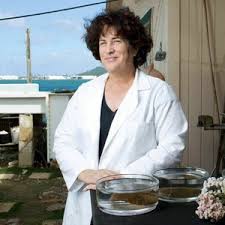
Dr. Mary Hagdorn
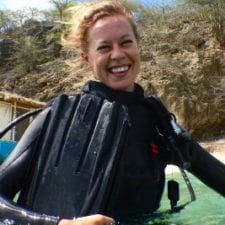
Dr. Kristen Marhaver
The Hagedorn group at the Smithsonian Institution has established genetic banks for coral throughout the world, successfully freezing coral sperm and coral larvae. The banks have been used for assisted gene flow and have demonstrated that cryopreserved sperm can be used for selected breeding, hybridization, and other applications. Together with Dr. Kristen Marhaver at Caribbean Research and Management of Biodiversity (CARMABI), Dr. Mary Hagedorn’s assisted gene follow experiments have demonstrated the successful use of cryopreserved sperm to fertilize and develop 4,700 juvenile Elkhorn corals (Acropora palmate, the largest living wildlife population ever created with cryopreserved material. (Hagedorn et al. 2018b).
The largest collection of frozen coral cells is at Taronga Conservation Society’s “Frozen Zoo”, which has enough frozen material to generate approximately 200 million coral colonies (Mary Hagedorn, personal communication). This program will expand enormously for the Great Barrier Reef in the next few years. Biobanking will play an important role within the large coral restoration and adaptation program that is about to be launched in Australia this year, and proposals for scaling up these facilities are currently being put forward for funding. However, these facilities may not be able to scale up to accommodate larger coral collections. MingDao University has also demonstrated successful sperm cryopreservation in China (Viakam et al. 2018), but it is not clear to what extent cryopreservation efforts are proceeding at scale in the region at this time.
A key technical challenge facing cryopreservation groups is the inability to preserve coral eggs . At this time, only coral sperm and larvae have been successfully frozen by the groups mentioned above. Frozen sperm still represents a highly valuable resource that may be used to bank alleles and genotypes on a reef at the present time. But without a supply of frozen ova, cryopreserved sperm must be paired with fresh ova, sourced from a living reef, live bank (aquaria), or nursery – or potentially from thawed gravid fragments. The challenge for the preservation of coral eggs is relatively steep and not inline with any mammalian species. Moreover, there are only a few mammalian species, such as humans, where egg cryopreservation is successful. Oocyte cryopreservation is very difficult. The challenges for coral eggs is that they are very large, filled with lipids, and only viable for a few days each year for a few hours. These technical difficulties will require advanced techniques, such as laser warming.
There is also a need to improve methods for freezing coral sperm. Current methods require highly concentrated sperm (not easy to obtain in open water), and are limited in throughput. Novel antifreeze proteins with low toxicity to coral cells are required. Experiments are necessary to identify appropriate freezing concentrations, fertilization concentrations, and sperm-egg ratios for each coral species. To put it another way, there is no one-size-freezes-all method for sperm cryopreservation. These challenges are being tackled one-by-one by a handful of scientists, and a concerted effort by the broader coral scientific community appears to be forming. However, the collaborations are largely ad hoc thus far. The cryopreservation community would benefit from administrative and operational support as it grows.
Cryopreservation capabilities and expertise is very limited among the current generation of reef biologists. Experts posit that training programs should be conducted as part of regional cryopreservation sub-programs. Such training programs would create local capacity for cryopreservation techniques for local species and conservation program staffers and would bank viable material during training.
Despite advances in throughput offered by mechanical cryopreservation systems, there is a major need for more practitioners of such methods because many corals spawn only once a year. This is the rate-limiting step. As such, it is not practical to have a single team operating year-round at many sites; instead, many teams should operate simultaneously at many sites. To sample many reefs, a “coral army” needs to be recruited, trained, managed, and provided with equipment and funds.
The dynamics of cryopreservation activities could change significantly once coral tissue fragments are shown to be reliably frozen and revived. Cryopreservation could then be conducted year-round, rather than only during annual spawning events. Currently, there are significant burdens on cryopreservation practitioners who must stay on station at reefs for up to 16 consecutive days, over multiple consecutive months, to sample germplasm and rapidly conduct larval crosses. Improving and scaling up methods for parallel larval crosses would be useful as well, as there is presently no established system for executing dozens of parallel gamete crosses and rinsing all material quickly to prevent polyspermy. Improved fertilization systems and methods are needed to produce larvae for cryopreservation on a parent-by-parent basis rather than in a single mixed-batch format and to increase capacity for replicated experiments on the fertilization process itself. A significant advance would be the identification of optimal fertilization and rinsing methods for as many species as possible and the development of larger-scale crossing and rearing systems. These improvements will considerable time and coordination as they must currently be conducted during the period when corals are spawning in the wild.
It is not clear if existing storage locations at Taronga and the USDA’s National Animal Germplasm Program will be able to scale their storage to meet the needs of the coral community in general. At this time it appears that there is no single dedicated coral cryopreservation facility available, nor is there a network that can coordinate the redundant sampling and banking required to provide long-term confidence that corals are banked in perpetuity. However, there are proposals around this within the reef restoration and adaptation program in Australia. The exact quantum of funding and resources is yet to be determined, and additional funding to match the government funds will be necessary. Regardless, this will likely be the single largest investment towards biobanking of coral material to date. Resolving the need for additional resources will require an understanding of the willingness among different stakeholders to engage and invest in cryopreservation capabilities at the present time, and to understand what the decision-gates are for unlocking funds.
Regulatory challenges complicate coral cryopreservation. The Convention on the International Trade of Endangered Species (CITES) and the Nagoya Protocol require extensive licensing and permitting to ensure corals can be legally sampled, transported across national borders, and legitimately used in research. These treaties have mandated all signatories to erect complex legislative barriers, which translate to significant legal and administrative overhead. Given that cryopreservation groups are likely to be operating across international borders from only a handful of source countries in the near term, either a either a workaround to legislative barriers must be developed, or additional support to cryopreservation groups must be provisioned in order to deal with the regulatory complexity associated with this activity.
A final challenge is that some States may even be reluctant to support public-facing cryopreservation programs for fear of sending a message that the responsible government is admitting failure in their efforts of conservation and environmental stewardship. This issue has been largely unreported in the literature, but poses a serious challenges to global conservation of coral genetic diversity.
Corals are almost entirely sourced using three approaches:
-
- by directly collecting adult corals from the wild,
- by collecting larvae from remote reefs during seasonal broadcast spawning events, or
- by fragmenting live corals already held in captivity (Craggs et al. 2016).
These three approaches cannot be universally applied to all corals and are unsustainable in the face of the overwhelming loss of planet’s reefs. Compounding these issues is the problem that corals cannot be easily bred in laboratory or aquarium settings without highly specialized equipment and training. Ultimately these issues translate to a major problem for coral researchers and conservationists – there is no truly reliable or convenient way to source corals or their larvae.
Emerging inducible spawning methods allow operators to source new corals in a laboratory environment. The technique makes use of an accurate simulation of corals’ natural environments in aquaria, modelling the photoperiod, seasonal insolation, lunar cycles and seasonal sea surface temperatures found in nature. This is coupled with attention to traditional coral husbandry techniques developed and honed in the aquarium and hobbyist trade.
The methods have been successful in inducing the captive broadcast spawning of at least 18 Acroporid species in a completely closed environment. Twenty-nine to 100 percent of colonies were shown to produce sperm and oocytes (egg cells) (Craggs et al. 2016).
Coral eggs generated from inducible spawning have since been fertilized with sperm of corals of the same species via IVF procedures, demonstrating that the technique can be used to generate offspring corals with parents from different locations that would not meet in nature. Inducible spawning thus provides a reliable source of eggs that could be paired with a coral sperm banking program to support a large breeding program focused on developing novel diversity.
Inducible spawning is a promising technique that can play a key role in assisted gene flow work, providing opportunities for coral farms or institutions distant from coral reefs to produce large numbers of coral larvae. Larvae and corals reared in captive spawning programs could be used to nurture juvenile corals for deployment in restoration programs and culturing experiments, to generate genetically diverse coral variants not found in nature, and to provide a source of germplasm that could be used for functional genomics experiments about the basis of coral biology. In particular, it is possible that the technique could be applied to corals that have survived stressor events in the wild, allowing new strains of thermally-tolerant corals to be produced independent of natural and precarious reef ecosystems.
The inducible spawning approach is also highly amenable to parallelized batch production of coral larvae. One vision for an inducible spawning facility is to support 365 different coral tanks for a particular coral species, such that the facility could provide regional larvae for experimentation and restoration on a daily basis (Jamie Craggs, personal communication).
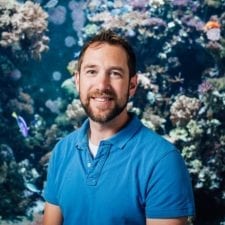
Jamie Craggs
The Project Coral team headed by Jamie Craggs at the Horniman Museum Aquarium in London is the leading group in inducible spawning and has pioneered the technique over the last decade. The group has established collaborations with Florida Aquarium and the California Academy of Sciences, both of which are now scaling up the approach for use in additional species. The team in Florida, led by Keri O’Neil, is focused on scaling up coral production for restoration activities in in the Gulf, Atlantic and Caribbean. The Cal Academy team led by Dr. Rebecca Albright is focused on ocean acidification research.
The Australian Institute of Marine Science is also developing inducible spawning techniques at their SeaSIM facilities, and beginning in mid-2019, the Reef Restoration and Adaptation Program will be working on this challenge as well.
The Project Coral team has noted the challenge in training new recruits and collaborators on their methodology, which can take at least as long as a single reproductive cycle (at least 1 year). To date there are little to no public training resources, and the technique must be learned tacitly, on location, or over great distances using 1-on-1 support. Inducible spawning remains a niche technique for the time being, and its nascent state and limited momentum is severely debilitating the propagation of skills to achieve critical mass. At the present time, there are very few people in the world who are adept at this technique, even in the laboratories that have developed or adapted the technology, of which there are three.
There is substantial interest from those working at the interface of coral physiology and genetic engineering, as well as from restoration practitioners. Meeting that demand is a major challenge.
There is an opportunity to expand the number of facilities operating programs like Project Coral, especially for species where inducible spawning protocols have yet to be established, and traditional propagation has failed to yield results. One vision would see regional associations of stakeholders such as public aquariums, commercial coral suppliers and wholesalers, and restoration facilities, collaborating to develop protocols for local species, and also to exchange germplasm for outbreeding programs in the longer term. However, such association would require careful planning, funding and even political management, each of which will present their own complications.
Finally there is some question of the true scalability of an inducible spawning program. The technique is understood to take at least one year to perfect with a novel coral, even for an experienced person, and there are substantial material and time costs to operating a specialized inducible spawning system. Moreover, larger aquaria are needed, putting it out of reach of hobbyists and those without such facilities. It also remains to be seen if aquariums, wholesalers, and researchers will be able to form a critical mass of inducible spawning operators that is sufficient to meet the need for coral restoration.
Coral stem cells have never been isolated or propagated in a laboratory setting, and experts have identified this capability as the most important priority for achieving genetic resilience in corals before even more corals are lost due to climate change. Stem cells have two important properties:
- Self-renewal, the ability to undergo numerous cycles of cell division without aging, and
- Potency, the capacity to differentiate into specialized cells and give rise to individual tissues or organisms.
Stem cells derived from adult tissues can be kept in culture and used for experimentation or to clone and propagate an individual organism without the use of sexual reproduction, and are therefore a useful and versatile new tool for restoration programs and research.
Putative stem cells have recently been isolated from corals, using mechanical dissociation of soft tissues from their skeletons, and subsequent fluorescent activated cell sorting (FACS) separated cell populations using different fluorescent dyes and tags (Rosental et al. 2017).
Recent work has demonstrated the value of “coral tissue plugs” in which a recipient coral from one reef will receive a donor plug from another reef and subsequently exhibited improved and donated fitness (Glynn et al. 2006). The convergence of these two areas of research are likely to give rise to a stem cell therapy approach for corals, for which there is technical precedent in the human medical sciences. The ability to manipulate coral stem cells and reconstitute colonies also opens up the possibility of cryopreservation of coral genotypes from adult tissues, a powerful complement to gamete cryopreservation (given the complexity of sourcing gametes) and a particularly important tool for coral species whose gametes cannot be collected. An incoming generation of coral stem cell experiments and the development of protocols to isolate stem cells from wild coral tissues could lay the groundwork for coral stem cell applications to rescue dying corals both in the lab and on the reef.
Given the outcomes of coral tissue plug transplantation, coral stem cells derived from novel strains may be propagated in a continuous manner in bioproduction facilities to support industrial-scale cell culture and subsequent transplantation into living corals, or otherwise used to farm stem cells into larvae and colonies using more traditional methods. The availability of coral stem cells would also open the door to more robust genome engineering projects by providing a source of otherwise-scarce individual coral cells. Researchers would then be able to edit corals at the single cell stage and more reliably avoid the issue of somatic mosaicism associated with later-stage genome editing, where some cells in the organism are edited and others remain unedited, typically confounding experiments.
The scalability of coral stem cell division could be leveraged to provide a continuous source of cells for larval rearing and outplanting, and thus serve as a critical biotechnology tool for extending and speeding assisted migration of particular genotypes. By pairing stem cells with genome engineering (already established in corals), stem cells could be modified to serve as a cellular vehicle to deliver genetic elements for heat resilience into coral reefs. Standard techniques for stem cell isolation from corals are likely to enable many other essential technology developments that can be leveraged.
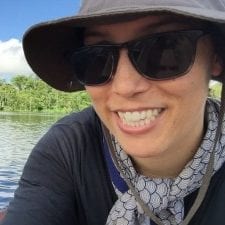
Dr. Nikki Traylor-Knowles
Dr. Nikki Traylor-Knowles at the University of Miami and Dr. Ben Rosental at Ben Gurion University are currently proposing research to further characterize and purify putative stem cells refine methods for their isolation; investigate their functionality and location in the holobiont using already developed cell tracking and transplantation methods; develop methods for in vitro stem cell propagation; and demonstrate the feasibility of stem cell transplantation as a therapeutic approach for saving corals.
Funding proposals are emerging from other consortia (Ventura et al. 2018; Shapiro et al. 2017), citing the potential to develop coral stem cell technologies alongside mechanical and microfluidic systems that would allow researchers to study the effects of thousands of diverse signaling factor combinations on cell viability, differentiation, and regeneration in a high-throughput fashion. The current proposals represent critical next steps for understanding and manipulating corals at molecular and ecological scales.
Identifying totipotency – the ability of a cell to become any other – in coral stem cells may prove challenging. This risk is compounded by a divergence of cell surface markers between coral species, meaning that the successful identification of stem cells could require challenging experimentation and fine-tuning of protocols on a species-by-species basis.
It is also unclear how effective the use of stem cell therapy for restoration will be. Success will generally depend on the precise way in which stem cells are to be used in each application, as well as the desired scale and production capacity of each group. It is unclear how amenable coral stem cells are to large-scale bioproduction, which may impact their longer term prospects. Regardless of the scale, high volume generation of coral stem cells would be subject to the constant challenges of bioproduction, including the need for round-the-clock management, disease control, and continuous optimization of growth conditions with changing scale and cell density per unit. Moreover, industrial-scale production is a long way off for a community only just beginning to evaluate the potential for coral stem cells.
There remain unanswered questions about the actual deployment of stem cells on a wild reef. Permission for stem cell transplantation, even without the use of genetic engineering, will likely require lengthy examination by public institutions, as there is no precedent for this in conservation science or biotechnology enterprise to date. On the one hand, the use of stem cells could be acceptable if genetic engineering is not used, as the cells would be from wild stock with beneficial and “natural” traits. On the other hand, stem cells or products containing them may be considered to be products of clinical relevance and be subject to a complex set of laws and regulations concerning production process, product characterisation, and dosing. Legal and regulatory perspectives will vary between States.
It appears that the more immediate scope for change emerging from coral stem cell technology is relegated to the lab, rather than on the reef. In the short term, the most salient challenge is to demonstrate the basics of coral stem cell isolation. In the medium term, the challenge is to assemble operating stem cell hardware-software-wetware systems that can meet real experimental objectives – in other words, the living and automated tools needed to manipulate coral stem cells with precision. This will be a great challenge for the coral community itself, requiring assistance from or field entry by engineers and biomedical experts. At the present time no one has yet put all of these components together into a working platform that fully ties together stem cells, microfluidics and FACS protocols for corals. While there have been promising innovations that partially bring elements of this platform together, such as the coral-on-a-chip system (Shapiro et al. 2017), these have not been used for significant R&D beyond the originator lab. While the benefits of stem cells as laboratory tools is clear, the long-term challenge will be to demonstrate that stem cell therapies are an effective and scalable tool for coral restoration, before addressing any relevant regulatory systems to govern their use in the wild.
Coral bleaching is a phenomenon involving the expulsion of photosynthetic Symbiodinium from coral polyps. Symbiodinium species differentially provide host corals with unique ratios of essential services. It is thought that the departure of one or more dominant or co-dominant Symbiodinium species during a period of stress leads to the invasion of another more appropriate species that can maintain photosynthesis function and resolve the stress response (Baker et al. 2001). In this way bleaching is typically considered to be a temporary event that lasts only a few days or weeks, and is a healthy coral’s reaction to changing conditions.
When the period of stress becomes protracted, bleaching can become chronic and the loss of the algal source of nourishment can cause the polyps to starve and die. The precise mechanism of coral bleaching remains unknown, and is complicated in that the breakdown of the endosymbiotic relationship between corals and Symbiodinium can be triggered by a large number of stressors including: high or low temperature, UV radiation, reduced salinity, microbial infection, marine pollutants, and even an absence of light. Taken together, this implies a complex set of genetic circuits involved in the maintenance of this critical relationship between coral and Symbiodinium, one that remains largely unknown to this day. The lack of knowledge about basic functional genomics in coral symbiont homeostasis is a major impedance to the development of safe and effective coral reef intervention and restoration strategies.
While the precise set of genomic mechanisms underlying bleaching is not yet understood, promising hypotheses provide numerous clues. The photo-inhibition model (Jones 2004) posits that high temperature leads to alterations in light capture, light utilization, heat dissipation, and a build-up of reactive oxygen species (ROS), or free radicals. ROS-scavenging enzymes become over-encumbered and denature, and the cellular outcomes are analogous to the mammalian inflammatory response – positive in short bursts, but harmful in chronic conditions as they inappropriately destroy healthy tissues (Palmer et al. 2008). Multiple groups are working on the characterisation of these protein responses in corals, and given the overlap with better-known mammalian responses to physiological stress, a list of gene targets putatively involved in the positive or negative resolution of coral bleaching is being developed (Hetz and Papa 2018; Ruiz-Jones and Palumbit 2017; Barshis et al. 2013).
The availability of lower-cost genome and transcriptome sequencing and analysis techniques has opened the door to conducting population-based assessments, for instance Genome Wide Association Studies (GWAS) on corals that have survived or died in bleaching events. Such work would support the identification of adaptive (and maladaptive) mutations in wild stocks and inform novel hypotheses about genotype-phenotype interactions and bleaching resolution. Moreover, the recent demonstration of the CRISPR genome engineering technique in corals allows researchers to investigate those hypotheses by way of targeted genetic engineering at low-throughput (Cleves et al. 2018) and potentially even high-throughput scales, such that functional and comparative genomics of mounting complexity are possible. Such techniques are crucial to advancing coral genomics to the level already attained with human cells and mouse models, and the therapeutic interventions enabled by advanced genomic knowledge.
A unifying factor to labs engaged in functional genomics investigations is their search for adaptive traits using comparative methods to develop actionable insight into natural selection in corals. Many of these labs employ widely used genomics tools and techniques from human biomedicine and functional genomics. However, the availability and maturity of analogous tools in coral-specific formats has only recently emerged, or has yet to emerge. The coral field must therefore catch up to the more mature human and mammalian genomics field and appropriately adapt its toolkit. Nevertheless, promising work is already emerging.
The Baums lab at the Pennsylvania State University has demonstrated the first steps toward genome-wide association studies (GWAS) by conducting a genome-wide SNP analysis for signatures of natural selection in the threatened Caribbean Elkhorn coral, Acropora palmata (Baums et al. 2017. The team revealed fine-scale population structure and inferred a major physical barrier to gene flow between populations. Scans detected 13 candidate genomic loci under positive selection, however there was no correlation between available environmental parameters and genetic distance. To this end, the team notes a critical barrier facing all coral functional genomics actors – the absence of fine-scale environmental and coral life history data, with which the putative adaptations may be correlated.
The van Oppen lab at Australian Institute of Marine Sciences, and the Gates lab at Hawai’i Institute of Marine Biology are both engaging in functional genomics experiments on coral and their symbionts, as parts of more involved projects pioneering assisted evolution and assisted gene flow (van Oppen et al. 2015). The groups have advocated for the potential and eventual use of synthetic biology for use in corals, reflecting a position that promotes the direct genetic engineering of corals and their symbionts. Both groups are primarily concerned with an initial discovery phase focused on exploring the natural diversity of coral functional responses to environmental stimuli. These groups have recognized that functional genomics insight will likely come from nature, rather than from engineering de novo mutations. Indeed, by investigating adaptations in the Indo-Pacific from Australia to Hawai’i, the groups are likely to identify a large set of potentially adaptive mutations across a broad geographic range in many coral species and environment types, fueling a promising second phase of engineering.
The Palumbi lab at Stanford uses molecular and physical approaches to understand the ways in which natural environmental parameters can modify coral physiology under changing conditions. In particular, this group is concerned with understanding how complex traits, such as heat resilience, are driven by hundreds of mutations in hundreds of genes, each with small effects that combine to have large outcomes. The group makes use of transcriptomics in corals and their model organisms, exposing wild corals from different environments to varied conditions over short timescales and measuring gene expression to characterize how each gene in each coral phenotype responds to these changes at the gene expression level. To this end, the Palumbi group uses an experimental stress system co-developed with the Barshis group at Old Dominion University. Indeed, the standardization of functional genomics tools across coral research groups could prove particularly useful by making relevant datasets directly comparable. One project underway by the Palumbi group seeks to functionally block gene expression by applying pharmaceutical agents known to disrupt particular genes and pathways, so as to determine the role of each gene. However, in the near term such an approach is likely to provide resolution of genes or pathways involved in adaptation, rather than more desirable knowledge about which mutations and nucleotide sequences are responsible. The latter could however be achieved by pairing this work with rational genome engineering experimentation to parallelize the “testing” of particular mutations in the genes identified.
The Pringle lab at Stanford University, in collaboration with the Bay lab at AIMS, have together demonstrated the use of CRISPR/Cas9 genome editing to functionally disrupt a single gene family in a coral species, marking the promise of an era in which any individual mutations identified as being adaptive (or maladaptive) in wild species could be edited into a coral genome for genetic rescue. Such a capability is in many ways critical to proving that a mutation exerts a causative effect, rather than a more simple correlative association with a trait. This capability may be regarded as the final step in bringing the “reverse genetics toolbox” online in coral, as well as the first step toward synthetic biology and forward genetics approaches, as advocated by the Gates and van Oppen groups. One key challenge is to demonstrate that a larger set of targeted genome editing outcomes can be achieved in more than one coral species such that CRISPR-based insertion, activation and interference options are available. These are all plausible and likely to be easily achieved. Another challenge is to automate the process used to deliver genome editing reagents into individual coral cells, which would support a scalable and high-throughput genome perturbation platform, something which is now common and often considered essential in functional genomics projects. Moreover there is a major need for a stable and productive source of single-celled corals, so that these can be made available to support wider use of genome engineering in coral genomics. These developments may come either from advances in coral stem cell propagation or otherwise from coral spawning technologies.
The Reef Genomics group, funded by the Great Barrier Reef Foundation, coordinated the sequencing and publication of the genomes of nine reef species found across the world, which will form foundations for functional genomics projects and will likely yield other important follow-on benefits as they are published. These genomes are available open access. Indeed, without the availability of coral reference genomes, functional genomics projects must rely on the use of genomes from closely-related model organisms which do not reflect the complexity of a coral genome (Shinzato et al. 2011). The Reef Genomics collaboration has provided critically-needed funds and direction to these efforts, as well as a repository and focal point for groups to collate data and publish their work. There is an obvious path of convergence between the projects contained within the Reef Genomics group, and trait description projects such as ReefBase and the Coral Traits database.
Note: Several of the labs mentioned above also conduct work related to other topics highlighted in this section, including epigenetics and holobiont manipulation.
There are ongoing efforts to establish reference genome sequences for coral species, a key element of any functional genomics project, but the work is slow and often produced using data coming from only a handful of individual organisms via pooled sequencing, or redundant sequencing of a single individual, and is not yet suitable for GWAS to be practical.
Unfortunately there are few completed efforts to obtain whole genome data from individuals of a species living in extreme or marginal environments, which would provide gold-standard insights into how particular genes and intergenic regions are enriched for certain mutations in those environments. Rather, genome sequencing and assembly projects tend to pool sequencing data from multiple individuals from the same species. Reference genomes are thus typically composites of multiple individuals, and may not be useful for assessing local adaptive variations. However, as pooled data is published and reference genomes become available, this will likely encourage the re-sequencing of multiple individuals without pool-seq, as the reference data structure will serve as a scaffold around which additional genomes can be assembled. Thereafter, the challenge will be to coordinate programs to obtain data from individual coral colonies on a large scale, and to log this data alongside abiotic data, so that correlation and causation patterns can be more easily identified and investigated.
Functional genomics groups often make use of knowledge derived from one species to assess the function of a gene in another. However, in corals the high degree of variability between individual coral species genome structure, as well as a significant number of genes present in corals that do not occur elsewhere in nature, complicates matters. This challenge is further compounded by the fact that a coral is a meta-organism composed of many species, to such an extent that the host coral genome in of itself may not be the only piece of the puzzle – functional genomics work may need to be extended to the bacterial, archaeal, and eukaryotic microbes that inhabit the coral, which will bring challenges of its own (detailed in subsequent sections).
There is currently no standard to measure coral physiological response, and there are few tools or parameters to assess coral health or other biological functions in a reliable manner. Some metrics do exist: wound healing, skeletal growth, bleaching resilience, infectious disease resilience, and reproductive output (Baums et al. 2018), but they are all rudimentary. Additional molecular assay development would be prudent as it would support direct measurements of particular traits across the coral research community, and dispense with the need to measure indirect indicators of physiological change.
With regard to the bioinformatics challenges in coral research, it is the scale of computational and intellectual work that requires attention. Numerous bioinformaticians will be needed to effectively sequence, assemble and annotate coral genomes, but there are few with the requisite skills to execute these projects in a timely manner within the coral research community itself. A more reasonable approach may see the involvement of dedicated genomics institutes or companies supporting the efforts to speed publication of the reference genomes that are fundamental to so many other elements of functional genomics programs.
Coral genetic engineers will need to be aware of translational synthetic biology, and must ideally practice a philosophy of public engagement as they publish their findings and take the next step toward engineered corals.
Phenotypic plasticity is a ubiquitous phenomenon that is increasingly gaining scientific attention. Corals from environmentally variable locations are generally better able to withstand stress through phenotypic plasticity and have greater adaptive potential compared to those that live in more stable environments (Torda et al. 2017). Most interestingly, there is mounting evidence that corals can adapt to different conditions, such that two genetically identical corals can exhibit different responses to the same conditions, with these adaptations being “learned” over time, as a coral is exposed to a novel environment.
The study of epigenetics is now the dominant research subject in this area, investigating all mechanisms that regulate gene expression. Understanding the epigenetic mechanisms by which corals are able to adapt to their environments by modifying gene expression (rather than by modifying their genomes), could provide a reliable means to intervene in the coral crisis without the need for breeding or genetic engineering. Indeed, the ability to generate “pre-adapted” coral colonies and larvae via epigenetic conditioning could allow the creation of seeding populations that repopulate reefs naturally, without the potential reduction of genetic diversity caused by artificially selecting corals, or the monumental effort required to restore reefs through continuous transplantation of single colonies. Such plasticity of phenotype is giving the coral research and restoration communities hope, but the precise epigenetic mechanisms of adaptation in corals remain poorly understood.
Evidence of phenotypic plasticity across a range of coral life-history stages and traits is mounting, highlighting significant capacity for corals to respond to altered environmental conditions. It has been shown that some corals can modulate their growth form to optimize light environments for photosynthesizing symbionts (Willis 1985), physiologically acclimate to resist elevated temperatures (Putnam et al 2016; Palumbi et al 2015), and show signs of acclimation under pH stress (Moya et al 2015).
Corals in the Persian Gulf survive temperatures that are too extreme for coral species elsewhere, while certain coral species naturally tolerate water with lower pH. On the Great Barrier Reef, temperatures vary by several degrees from North to South and large temperature differences also exist within the majority of reefs between habitats and depths. The thermal tolerance of corals generally reflects their local temperature environment, meaning that corals in warmer waters bleach at higher temperatures than those to the cooler waters.
In such cases, the genotype remained the same, but its expression was altered due to changes in epigenetic structure. These examples suggest that corals retain phenotypic plasticity in their adult life stage. The revolution in -omics approaches, in particular ChIP-seq and other means of detecting and measuring epigenetic modifications, provide innovative opportunities for exploring different epigenetic components in coral adaptive responses. Moreover, CRISPR has recently been adapted to artificially modify epigenetic states in a predictable manner, opening the door to meaningful epigenetic experimentation (Enriquez 2016).

Holly Putnam
The Putnam lab at the University of Rhode Island is a leader in the application of epigenetics to coral acclimatization, and is striving to understand how the abiotic environment and biotic interactions drive organism phenotype, ecological patterning, and evolutionary processes through the interaction of symbiosis, genetics, and epigenetics. The group is presently investigating whether phenotypic variation in coral larvae among different physiographic reef zones is related to genetics over and above epigenetics.
In Australia, researchers at AIMS are currently engaged in a number of experiments to measure epigenetic changes and genetic adaptations, and the conditions under which they can be promoted. Multiple groups are taking advantage of long-term “stress-conditioning” experiments occurring at the National Sea Simulator, which seek to acclimate corals to future thermal and pH conditions, using directed and assisted evolution methods in conjunction with epigenetics approaches. The van Oppen group is using these findings as part of a larger interest in deploying synthetic biology techniques to engineer or breed coral resilience (van Oppen et al. 2015). The AIMS project in general examines how conditioning occurs in corals, under what conditions it can be optimized, and whether it can prepare offspring for further ocean warming and acidification. Projects of this type are notable in that they will provide insight into the potential for coral larvae to be pre-conditioned to an environment, prior to their actual deployment in a reef restoration project. If successful, it could add an additional dimension for improving the resilience of coral reefs in the face of climate change, and potentially other stressors.
The Aranda Group at King Abdullah University of Science and Technology (KAUST) in Saudi Arabia has discovered extensive DNA methylation in the genome of a Red Sea Coral, and identified specific patterns of epigenetic marks which emerge when corals are stressed for prolonged periods (Liew et al. 2018). Their research currently focuses on understanding the exact ways these mechanisms work and to what extent they allow corals to adapt, alongside the impact of microbial changes on these systems.
Note: There are a great many other groups interested in epigenetics of the coral holobiont, rather than the coral host, and the subject is deliberately discussed in more detail in the following section.
The mechanisms and impacts of epigenetic adaptation in corals are challenging to segregate from genetic adaptations and other adaptations or parameters in an organism’s genome or general life history. This will prove especially challenging given the limited experimental capacity and epigenetic toolkits available to marine biologists. Epigenetic tools will need to be adapted from other areas of the biological sciences, and potentially require input from specialists on a case-by-case basis. Furthermore, it is a distinct possibility that epigenetics will not be widely conserved between coral species.
Epigenetic changes in corals themselves are only one piece of a more complex puzzle, with extreme complexity emerging from the multitude of epigenetic states that may exist across the entire coral holobiont, which may consist of many thousands of distinct organisms (discussed below). Understanding the epigenetic and adaptive capacity of each organism, and understanding the interplay between them requires the application of -omics and molecular approaches within a rigorous experimental framework. Adaptive capacity might be highly variable across different coral species, and a model organism approach may be far more tractable in the short-term, but present additional challenges, namely to do with the extrapolation of one model to all corals.
Corals transcend our definitions of neatly-packaged species, and are better referred to as “holobionts” – metaorganism communities in which a single “individual” is composed of: the specific host coral animal, one or more species of Symbiodinium, and a collection of bacteria, viruses, fungi, archaea, protists and other microorganisms. The holobiont has been shown to serve as a metabolically complete system, where genes from multiple organisms act together to cycle essential nutrients from one organism to another, in mutually beneficial cycles (Rowher and Youle 2010), that adapt to survive adverse conditions (Abrego et al. 2008). Each coral species plays host to more than 100 unique bacterial species, which occupies a different spatial niche on the coral colony (Rowher and Youle 2010). More than 100 million microbes occupy each square centimeter of coral surface, and they are distinct from the microbes that occupy the water column. Further, the holobiont composition shifts in response to changing environmental conditions (Rowher and Youle 2003). The general states in which coral holobionts exist, form metabolically complete circuits, undergo changes, and impact an individual coral’s ability to resolve stress or injury, remain almost entirely unknown.
It has been demonstrated that local natural adaptation to distinct reef habitats has occurred in the wild, through natural selection on at least three members of the coral holobiont: the coral host, its Symbiodinium and the tissue-associated bacteria.
Omics tools have, in particular, supported the emergence of an innovative field of functional metagenomics in coral holobionts. Engineering the microbiome has been proposed by several groups, but has not yet been widely reported experimentally. Nevertheless, studies have already ranged from examining the preference of corals with particular microbiomes for a particular substrate to guide initial larval settlement, to documenting the ability of coral-associated viruses to augment the coral immune system, and for various surface microorganisms species to engage in nutrient cycling. It is posited that information about the reef microbiome can be used to drive assessments of the suitability of a location for a particular restoration approach and unlock new directions in engineering the coral holobiont itself (Rowher, personal communication; Peixoto et al. 2017). Symbiodinium species have in particular, received great attention as they are one of the ubiquitous constituents of the coral microbiome, and could potentially be manipulated to be resilient to disturbed conditions.
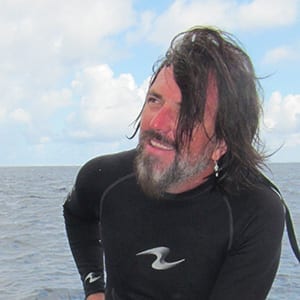
Forest Rohwer
The Rohwer-Wegley Kelly group at San Diego State University is a pioneering developer of fundamental microbial reef genomics and metagenomics and was an early contributor to the field. The group is currently using metabolomics to gain insights into the relatedness of unknown coral holobiont molecules based on their molecular fingerprints, and is illuminating how and why specific molecules are created by coral holobionts in response to particular stimuli. Additionally the group has pioneered investigations into the mechanisms by which corals are able to assimilate and express viruses in their external mucous, as part of an immune system that protects them from marine pathogens, and has also identified other immune-relevant interactions between corals and their microbes (Rowher and Youle 2010). The group has further documented significant variation between coral species’ microbial communities (Rowher and Youle 2010).
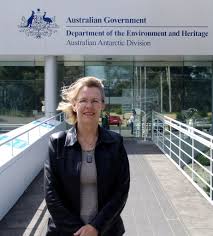
Linda Blackall
The Marine Microbial Symbiosis (MMS) group, a joint group headed by Dr. Madeleine van Oppen and Dr. Linda Blackall of the University of Melbourne is investigating the fundamentals of coral-microbe symbiosis using experimental evolution, genome editing, and epigenetic alteration via stress conditioning. Symbiodinium physiology, engineering and metagenomics projects are underway by the MMS, as is the application of these methods to other microbial species in the holobiont. There remains a need to identify and characterize organism-specific functions within the holobiont. To this end the team is using metagenomic approaches to determine the microbial community structure and its properties.
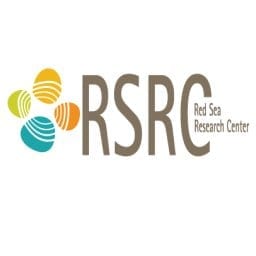
Red Sea Research Center
The Coral Symbiomics group, run by Dr. Aranda at KAUST, is determining the evolutionary history of the relationships between coral, microbe and symbiont, and characterizing the mechanisms that make them evolutionarily stable by using whole genome sequencing and comparative multi-omic approaches. The group is analyzing the genes and associated functions and proteins used in the regulation of all aspects of symbiosis. In particular, the group has demonstrated that corals and related organisms share a common core set of thermal stress response pathways for dealing with protein-(mis)folding and reactive oxygen species observed in bleaching and known to be important to the homeostasis of symbionts (Cziesielski et al. 2018). The group has observed enhanced resilience in Red Sea coral holobiont organisms, likely through association with specific strains of Red Sea symbiont not found anywhere else.
The Voolstra Reef Genomics group at KAUST is further exploring the north-south environmental gradients of the Red Sea to gain a greater understanding of why the majority of Red Sea coral is healthy and more heat resilient to stresses versus reefs found in other parts of the world. The group uses a broad range of tools (genetics, genomics, bioinformatics, ecology, microbiology) to study marine ecosystems, specifically how they are structured, how their members interact, and how they are influenced by physical processes. The group uses a true eco-systems biology and environmental genomics approach that explores many scales of organism and environment type. Voolstra’s team has shown that bacterial community dynamics are closely associated with, and may even drive, coral heat tolerance (Ziegler et al. 2017).

Raquel Peixoto
Dr. Peixoto, currently based at UC Davis, has advanced with her colleagues at UFRJ, Brazil, a concept of system-wide probiotic manipulations as part of a “Beneficial Coral Microorganisms” (BCMs) hypothesis (Peixoto et al. 2017). The BCMs concept is analogous to the Plant Growth Promoting Rhizosphere (PGPR) concept, which has been widely explored in the agricultural industry. PGPR concerns the microorganisms that inhabit the rhizosphere (root-associated niches) of plants, and the ways in which they directly or indirectly promote plant growth and development through the production of regulatory signals, antibiotics and nutrients. Peixoto and her colleagues have proposed similar potential mechanisms of the effects of BCMs on coral holobiont health, and have suggested strategies for the use of this knowledge to manipulate the microbiome, reverse dysbiosis (bleaching and other effects of a breakdown of the symbioses), and restore and protect coral reefs. Currently Dr. Peioxoto’s work is directed toward development of BCM consortia as environmental “probiotics” to improve coral resistance or recovery before and after bleaching events, and to develop BCMs as a tool in human-assisted adaption to shifting environmental conditions (Peixoto et al. 2017). The project recently received support from the Great Barrier Reef Foundation (GBRF) under its Out of The Blue Box challenge, and the next step in the research will explore a range of delivery methods to identify the best way to introduce putative BCMs into a coral system. A key challenge will be to develop “broad spectrum” BCMs that can enhance health in many corals, without negatively impacting other marine organisms and corals.
The scale of work involved in decoding coral microbiomes is impressive. With over 1000 species of soft and hard coral, there may be as many as 100,000 unique bacterial species directly partnered with Earth’s corals, not to mention the non-specialist bacteria and other microorganisms that may be more casually associated with corals. To this end, the concept of generalist BCMs suitable for multiple coral species has been met with skepticism by some in the coral research community, but is not necessarily infeasible – at least given the current state of research, which is in promising first stages. Indeed, restoration without the manipulation or use of BCMs or microbial manipulations may prove to be a naive approach in the longer term, but this remains speculation. Tension between these two extremes may resolve as more research interest is cultivated in this subject, and findings are published. In other words, it is too early to tell if BCMs will be effective.
More generally, many microorganisms cannot be cultured directly, so researchers must rely on the use of -omics tools and measurement approaches to assess their presence and function. In most cases, coral researchers are generally unfamiliar with microbiome tools, as they are not yet widely available among the coral research community, and have only recently emerged in other branches of biology. Regardless of one’s ability to measure the presence of a particular organism, the culture issue could prove problematic – especially if an organism is found to be essential to holobiont health and performance, but cannot be cultured under laboratory conditions or industrially scaled. Other, eukaryotic microorganisms that may be suitable for culture could be very challenging to genetically engineer; Symbiodinium, thought to be the keystone for microbial manipulation, is particularly difficult to “genetically transform,” an achievement which has only been reported once.
Evidence is accumulating that although some host-associated microbes might facilitate adaptive responses in corals, there are fitness tradeoffs between each adaptation, which remain unclear at the present time and will prove difficult to characterize in detail. Furthermore, it is not clear whether microbial/holobiont manipulations could prove to harm corals by stimulating, rather than resolving, dysbiosis or how these manipulations may vary in different coral species. Such questions will need to be categorically answered before large-scale use of BCMs and holobiont manipulation is to receive informed consent, which may prove challenging. To this extent there are likely to be considerable regulatory challenges on the road to deploying these techniques in the wild.
It is well-documented that corals genetically adapt to their local conditions (Polato et al. 2010; Barshis et al. 2013; Dixon et al. 2015), and each species is effectively made of sub-populations adapted to diverse environments. Despite the hopeful tone for genetic engineering applications, these technologies are not yet ready for field use in corals, and cannot readily make use of genetic adaptations in a meaningful way (National Academies Consensus Report 2018). Currently, the only practical approach to improving reef resilience is to harness and foster the adaptive genetic diversity that is already present in coral populations by harnessing the power of natural admixture and breeding of coral subspecies and by applying these tools in active reef restoration contexts.
Natural recombination and breeding have given rise to resilient corals in the past, and could give rise to new resilient corals in the future. However declining environmental conditions across most reef sites has destroyed reefs and is reducing connectivity between reef meta-populations. This will likely grow worse over the coming years, minimizing the ability of corals to naturally encounter one another, fertilize one another during breeding events, and subsequently create more resilient subspecies in the wild. As such it falls to conservation and restoration practitioners to actively restore reefs made up of appropriate coral genotypes, so that connectivity gaps between distant reefs may be filled with newly-restored, genetically-robust reefs, and restored reefs can be further invigorated with corals that have been specifically chosen for beneficial adaptive traits and genotypes.
Essentially, the goal of coral translocation, genotype selection, and active reef restoration is to establish self-sustaining populations of sexually reproducing corals that have sufficient genetic variation to adapt to changing environments over time. Such a goal requires integration and application of knowledge concerning adaptive genetic and epigenetic traits in the coral host and larger holobiont, alongside a program focused on physically relocating corals over large distances.
Coral relocation has already been established as an appropriate restoration technique in select cases, particularly where corals are scheduled for destruction due to human development. However, severe and frequent mortality events have already exerted strong selection pressure on coral populations and have selected for wild alleles that are more likely to spawn a new generation of better-adapted corals (Libro and Vollmer 2016; Muller et al. 2018). Guidelines have been presented to support and standardize human-assisted migration with the aim of re-establishing or bolstering coral populations that are capable of sexual recruitment and genetic exchange of these adaptive wild alleles (Baums et al. 2018).
Current proposals contemplate much-needed enhancements to restoration practices such as routine genotyping of propagated stock, trait-based assessment of genotype performance, jump-starting genetic admixture by producing first-generation offspring in the lab for out-planting, and the deliberate facilitation of longer-range genetic exchange through assisted migration and assisted gene flow. The integration of these advanced technologies to guide translocation is a promising step away from “simply moving” coral reefs, and a step toward long-term ecosystem restoration and revitalization, which makes use of the cutting-edge tools of coral biotechnology and conservation practice.
Physical means of relocating corals en masse is likely to benefit greatly from advances in the use of cryopreservation, as well as the use of larval rearing and freezing programs, which will significantly reduce the volume and complexity of coral relocation efforts.
At the present time there are even early stage proposals to develop large scale “coral arks” that consist of modular sub-arks that can each be submerged to capture the broad range of coral reef diversity onto a fixed structure over an extended period. After an appropriate amount of time the modules could be re-assembled into a larger ark super-structure which can be towed to submarine sea mounts in cooler waters, with the goal of translocating or seeding entirely novel ecosystems (at the expense of a pre-existing local ecosystem).
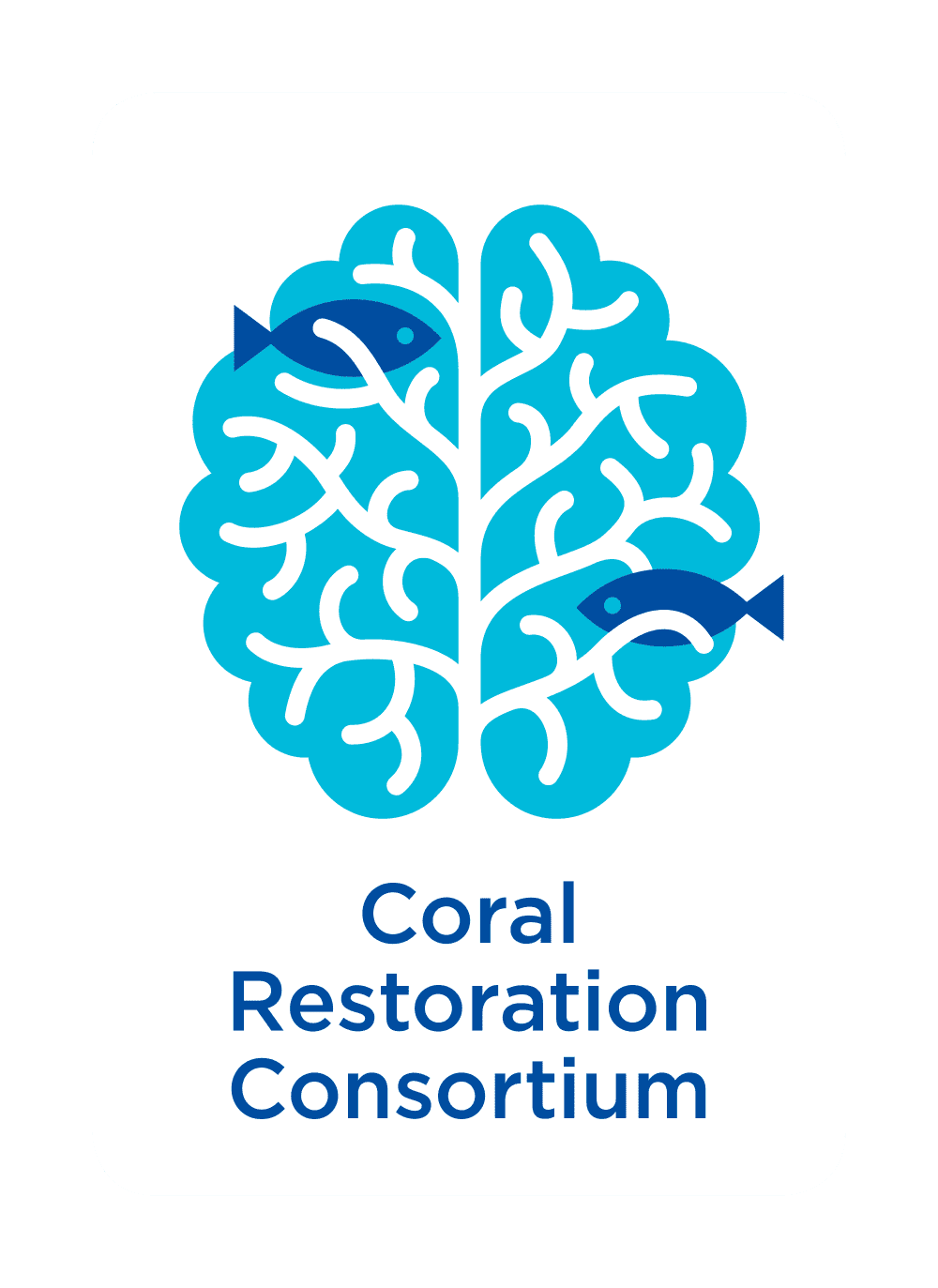
The Coral Restoration Consortium (CRC) is the leading community comprised of scientists, managers, coral restoration practitioners, and educators dedicated to enabling coral reef ecosystems to survive the 21st century and beyond. The group collaborates and shares technology and best practices between participants, and facilitates scientific and practical ingenuity needed to demonstrate that restoration can achieve meaningful results at scales relevant to reefs in their roles of protecting coastlines, supporting fisheries, and serving as economic engines for coastal communities. Organizers and advisory board members include experts from the NOAA Coral Reef Restoration Program, NOAA Fisheries Office of Science and Technology, Mote Marine Laboratories, UN Environment-Caribbean Environment Programme, SECORE, The Nature Conservancy, and Seascape Caribbean. The CRC is comprised of seven active CRC Working Groups focused on: Land-Based Propagation, Field-Based Propagation, Larval Propagation, Demonstration Projects, Genetics, Monitoring, and Management. Each working group is chaired by one to four active practitioners and experts in the subfields. The CRC recently established the Reef Futures conference, which will bring together restoration experts, planners, and practitioners on a regular basis. CRC was founded during a 2016 workshop focused on coral restoration specifically in the Caribbean Sea, but since that time has expanded in scope to encompass global coral propagation and restoration.
Coral translocation has proceeded even prior to the formation of the CRC. In Jordan in 2017, authorities proposed a plan to relocate an existing port to a new area towards the southern end of the Gulf of Aqaba (Kotb 2016). As a mitigation measure, a group funded by the United Nations Development Program (UNDP) and Global Environment Facility (GEV) translocated 7000 endangered coral colonies from Al-Dirreh and transplanted them into degraded reef sites in Aqaba Marine Park. Overall survival rate for transplanted colonies was 87 percent. High survival and linear growth rates indicate that the transplantation site selection and the techniques employed were successful (Kotb 2016), and demonstrate powerful proof-of-principle for large-scale mature coral translocation efforts.
In Australia’s Heron Island, a translocation and reproduction trial was conducted in which a large amount of coral spawn and eggs were collected, grown into larvae off-site, and then transplanted onto areas of damaged reef (Dela Cruz and Harrison 2017). After an eight month period, and with the assistance of underwater mesh tanks to reduce predation and ocean current interference, juvenile corals were successfully grown. The Australian experiment made use of high-density coral larvae enclosures, a significant step away from “coral gardening” which requires the use of a dedicated coral nursery site. This has promising implications for large scale translocation of juvenile corals, rather than bulkier mature corals.
There are promising precedents for coral translocation, with a good deal of work having been conducted over many decades. As yet, these uses of genetic insight to guide translocation efforts remain untested and unclear, putting the idea of a self-sustaining super-reef into doubt in the short term. Presently our understanding of genotype-phenotype relationships is rudimentary (described above), making it difficult to rationally select corals for use in translocation programs. These current approaches, based on phenotypic traits, are not comprehensive, and at present we do not know the sequence profiles of potentially adaptive alleles in order to successfully (and more easily) identify relocation candidates using DNA sequencing. Further, given the nascent state of coral functional genomics and genome engineering, it is unlikely that the community will have actionable results until functional genomics yield widely agreed upon conclusions. Finally, there are very few reliable biomarkers that can be used to facilitate the identification of candidate corals for translocation or breeding. To this end, coral translocation may be operating in the dark, without reliable molecular guidance to light the path forward for the foreseeable future. Such a dependency is likely to seriously impact the successful outcome of coral translocation in both the near and long term.
The CRC Genetics Working Group has concluded that capturing only 4 unique coral genotypes per reef type, along an environmental gradient, will generally be enough to capture >50 percent of the common alleles in a population (where 10 genotypes = 90 percent of the alleles, and 20 genotypes = ~100 percent) (Baums et al. 2018). However, without a targeted identification and collection system that is capable of easily identifying the most suitable corals, at this time only the most common genotypes are likely to be well-represented by a coral capture and translocation program. As such, it may prove challenging to collect corals that have suitable adaptive traits, until such identification tools or molecular assays are widely available.
Additionally, short-term adaptive responses, which are based on the genetic profile of a first-generation translocated coral, may only be sustained by future generations if the out-planted coral genotypes are able to successfully reproduce and generate novel allele combinations with sustained hybrid vigor over subsequent generations. As such, the long term success of translocation efforts may require ongoing interventions though continued sexual propagation and breeding programmes that continuously augment designer reefs, a prospect that presents major challenges. Furthermore, while it has been proposed that large populations of corals with varied genetic backgrounds could be strategically translocated in patterns to enable the largest amount of admixture and guarantee sexual recombination, there are many environmental parameters (temperature, current, predators etc.) that could easily interfere with successful reproduction.
While the translocation examples provided above were considered successful in their own right, these particular projects did not assess the impact of translocation on shorter term fecundity, nor did they assess long-term reproductive fitness of the translocated corals in historical or new environments. Such documentation has often been neglected due to legislative requirements, or a lack of funding, or site accessibility (Precht 2016).
Building on the above, reliable means to assess a reef’s suitability for restoration and translocation are much needed. There is a particular need for establishing a more comprehensive and widely used system of biotic and abiotic measures and orders of coral provenance, such that a coral’s life history and traits can be more easily logged and communicated. Elements established in the ReefBase global information system for coral reefs, as well as NCBI genomics standards, are useful places to start in this regard.
References
Abrego, David, et al. “Species–specific interactions between algal endosymbionts and coral hosts define their bleaching response to heat and light stress.” Proceedings of the Royal Society of London B: Biological Sciences 275.1648 (2008): 2273-2282.
Baker, Andrew C. “Ecosystems: reef corals bleach to survive change.” Nature 411.6839 (2001): 765.
Barshis, Daniel J., et al. “Genomic basis for coral resilience to climate change.” Proceedings of the National Academy of Sciences 110.4 (2013): 1387-1392.
Baums et al. (in prep), ‘How to maximise the adaptive potential of restored coral populations’, unpublished manuscript.
Burke, Lauretta, et al. Reefs at Risk Revisited. 2011.
Cleves, Phillip A., et al. “CRISPR/Cas9-mediated genome editing in a reef-building coral.” Proceedings of the National Academy of Sciences 115.20 (2018): 5235-5240.
Costanza, Robert, et al. “Changes in the global value of ecosystem services.” Global Environmental Change 26 (2014): 152-158.
Craggs, Jamie- personal communication.
Craggs, Jamie, et al. “Inducing broadcast coral spawning ex situ: Closed system mesocosm design and husbandry protocol.” Ecology and Evolution 7.24 (2017): 11066-11078.
Cziesielski, Maha J., et al. “Multi-omics analysis of thermal stress response in a zooxanthellate cnidarian reveals the importance of associating with thermotolerant symbionts.” Proceedings of the Royal Society of London B: Biological Sciences 285.1877 (2018): 20172654.
Daly, Jonathan, et al. “Successful cryopreservation of coral larvae using vitrification and laser warming.” Scientific Reports 8.1 (2018): 15714.
dela Cruz, Dexter W., and Peter L. Harrison. “Enhanced larval supply and recruitment can replenish reef corals on degraded reefs.” Scientific Reports 7.1 (2017): 13985.
Devlin-Durante, Meghann K., and Iliana B. Baums. “Genome-wide survey of single-nucleotide polymorphisms reveals fine-scale population structure and signs of selection in the threatened Caribbean elkhorn coral, Acropora palmata.” PeerJ (2017): e4077.
Dixon, Groves B., et al. “Genomic determinants of coral heat tolerance across latitudes.” Science 348.6242 (2015): 1460-1462.
Enríquez, Paul. “Focus: Epigenetics: CRISPR-Mediated Epigenome Editing.” The Yale journal of biology and medicine89.4 (2016): 471.
Fahy, Elizabeth Glynn, et al. “Growth and survivorship of scleractinian coral transplants and the effectiveness of plugging core holes in transplant donor colonies.” (2006).
Hagedorn, Mary- personal communication
Hagedorn, Mary, et al. “Producing Coral Offspring with Cryopreserved Sperm: A Tool for Coral Reef Restoration.” Scientific reports 7.1 (2017): 14432.
Hagedorn, Mary, et al. “Successful demonstration of assisted gene flow in the threatened coral Acropora Palmata across genetically-isolated Caribbean populations using cryopreserved sperm.” bioRxiv (2018): 492447.
Heron, Scott Fraser, et al. “Impacts of climate change on World Heritage coral reefs: A first global scientific assessment.” (2017).
Hetz, Claudio, and Feroz R. Papa. “The unfolded protein response and cell fate control.” Molecular cell 69.2 (2018): 169-181.
Jokiel, Paul L., et al. “Review of coral reef restoration and mitigation in Hawaii and the US-affiliated Pacific Islands.” Coral reef restoration handbook, CRC Taylor & Francis, New York (2006): 271-290.
Jones, Ross J. “Testing the ‘photoinhibition’model of coral bleaching using chemical inhibitors.” Marine Ecology Progress Series 284 (2004): 133-145.
Kotb, Mohammed MA. “Coral translocation and farming as mitigation and conservation measures for coastal development in the Red Sea: aqaba case study, Jordan.” Environmental Earth Sciences 75.5 (2016): 439.
Libro, Silvia, and Steven V. Vollmer. “Genetic signature of resistance to white band disease in the Caribbean staghorn coral Acropora cervicornis.” PloS one 11.1 (2016): e0146636.
Liew, Yi Jin, et al. “Epigenome-associated phenotypic acclimatization to ocean acidification in a reef-building coral.” Science advances 4.6 (2018): eaar8028.
Moya, A., et al. “Rapid acclimation of juvenile corals to CO2‐mediated acidification by upregulation of heat shock protein and Bcl‐2 genes.” Molecular ecology 24.2 (2015): 438-452.
Muller, Erinn M., Erich Bartels, and Iliana B. Baums. “Bleaching causes loss of disease resistance within the threatened coral species Acropora cervicornis.” eLife 7 (2018): e35066.
National Academies of Sciences, Engineering, and Medicine. 2018. A Research Review of Interventions to Increase the Persistence and Resilience of Coral Reefs. Washington, DC: The National Academies Press. Doi: https://doi.org/10.17226/25279
Palmer, Caroline V., Laura D. Mydlarz, and Bette L. Willis. “Evidence of an inflammatory-like response in non-normally pigmented tissues of two scleractinian corals.” Proceedings of the Royal Society of London B: Biological Sciences 275.1652 (2008): 2687-2693.
Palumbi, Stephen R., et al. “Mechanisms of reef coral resistance to future climate change.” Science 344.6186 (2014): 895-898.
Peixoto, Raquel S., et al. “Beneficial microorganisms for corals (BMC): proposed mechanisms for coral health and resilience.” Frontiers in microbiology 8 (2017): 341.
Polato, Nicholas R., et al. “Location-specific responses to thermal stress in larvae of the reef-building coral Montastraea faveolata.” PLoS One 5.6 (2010): e11221.
Precht, William F. Coral reef restoration handbook. CRC press, 2006.
Putnam, Hollie M., Jennifer M. Davidson, and Ruth D. Gates. “Ocean acidification influences host DNA methylation and phenotypic plasticity in environmentally susceptible corals.” Evolutionary applications 9.9 (2016): 1165-1178.
Rohwer, Forest- personal communication
Rohwer, Forest, Merry Youle, and D. Vosten. Coral reefs in the microbial seas. Vol. 1. Granada Hills: Plaid Press, 2010.
Rohwer, Forest. “Life and death of coral reefs: a microbial view.” OCEANS 2003. Proceedings. Vol. 1. IEEE, 2003.
Rosental, Benyamin, et al. “Coral cell separation and isolation by fluorescence-activated cell sorting (FACS).” BMC cell biology 18.1 (2017): 30.
Ruiz-Jones, Lupita J., and Stephen R. Palumbi. “Tidal heat pulses on a reef trigger a fine-tuned transcriptional response in corals to maintain homeostasis.” Science Advances 3.3 (2017): e1601298.
Shapiro, Orr H., et al. “A coral-on-a-chip microfluidic platform enabling live-imaging microscopy of reef-building corals.” Nature communications 7 (2016): 10860.
Shinzato, Chuya, et al. “Using the Acropora digitifera genome to understand coral responses to environmental change.” Nature 476.7360 (2011): 320.
Torda, Gergely, et al. “Rapid adaptive responses to climate change in corals.” Nature Climate Change 7.9 (2017): 627.
UK-First – Coral IVF at the Horniman.” Horniman Museum and Gardens. Accessed June 25, 2018c. https://www.horniman.ac.uk/get_involved/news/uk-first-coral-ivf-at-the-horniman.
van Oppen, Madeleine JH, et al. “Building coral reef resilience through assisted evolution.” Proceedings of the National Academy of Sciences 112.8 (2015): 2307-2313.
Ventura, P., et al. “Cnidarian Primary Cell Culture as a Tool to Investigate the Effect of Thermal Stress at Cellular Level.” Marine Biotechnology 20.2 (2018): 144-154
Viyakarn, Voranop, et al. “Cryopreservation of sperm from the coral Acropora humilis.” Cryobiology 80 (2018): 130-138.
Wilkinson, Clive CR. Status of coral reefs of the world: 2004. Australian Institute of Marine Science (AIMS), 2004.
Willis, B. L. “Phenotypic plasticity versus phenotypic stability in the reef corals Turbinaria mesenterina and Pavona cactus.” Proceedings of the Fifth International Coral Reef Symposium. Vol. 4. 1985.
Zeng, An, et al. “Prospectively isolated Tetraspanin+ neoblasts are adult pluripotent stem cells underlying planaria regeneration.” Cell 173.7 (2018): 1593-1608.
Ziegler, Maren, et al. “Bacterial community dynamics are linked to patterns of coral heat tolerance.” Nature Communications 8 (2017): 14213.

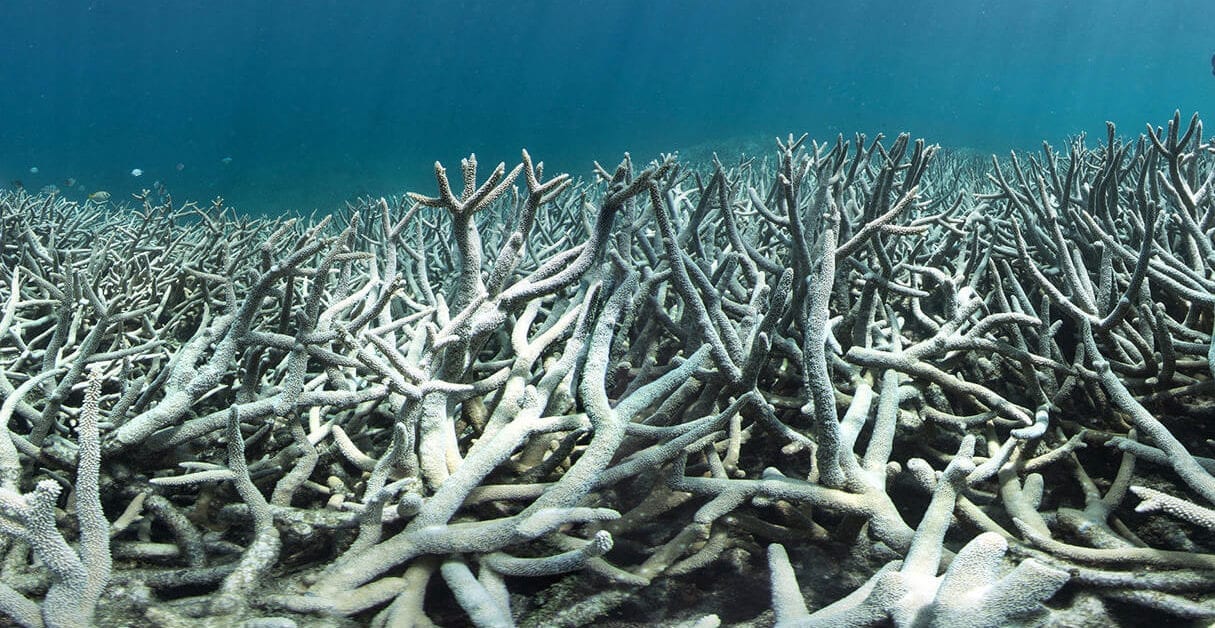
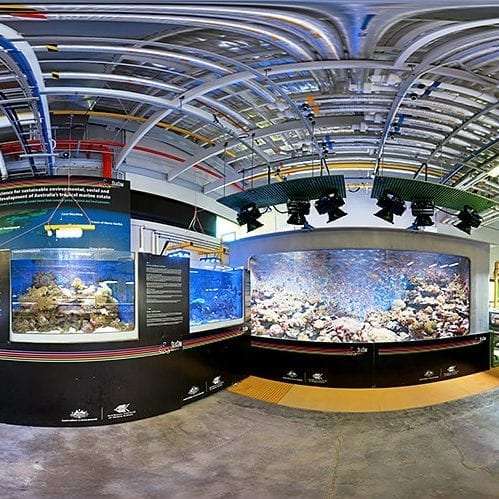




Back to Top